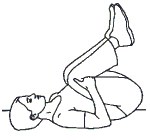Back pain
Back pain is very common with about 80% of people affected during their lifetime. In the majority of cases there is not a serious cause, and no immediate treatment is required.
Your back is made up of various muscles, strong ligaments and tendons which attach to your spine. The spine is made up of bones called vertebrae with cartilage discs in between each one. The spine carries your spinal cord and nerves. Your back provides support for your body and allows flexibility and movement.
What is the cause of back pain?
The majority of cases are non-specific and usually due to a mechanical problem with the muscles or ligaments such as a sprain.
Most back pain will improve within a few weeks as the tissues heal. Some people may go on to develop “chronic back pain” if it lasts more than three months. This is often due to the nerves being more sensitive to different movements or the muscles not being strong enough to cope with normal daily loads. This is very common. It does not need urgent medical attention. A physiotherapist can help you strengthen the muscles and improve your mobility.
What tests do you need?
In most cases you will not need any further tests. A full clinical examination carried out by a doctor or physiotherapist is much more accurate at diagnosing your problem than any imaging. The majority of tests will be negative and do not quicken your recovery. Current UK guidelines state that X-rays and scans should not be carried out for normal back pain.
When should you go to the A&E?
On rare occasions back pain does need emergency attention if:
- You have difficulty emptying or controlling your bladder, or controlling your bowels
- You have numbness around your bottom and saddle area (eg difficulty feeling toilet paper when wiping)
- You have pain down both legs, weakness or difficulty walking
- You have had a recent significant injury affecting your back
When should you go to your GP?
You should seek GP attention if your back pain is continually affecting your sleep and your daily activities. Your GP can refer you for physiotherapy. Seek GP attention if:
- You are younger than 20 or older than 55 when you get back pain for the first time
- You have lost a significant amount of weight for no reason
- You have had cancer or TB in the past
- You have known osteoporosis
- You have pain in your upper back without any injury
- Your pain is constant, unremitting especially at night, and is getting worse
- You are experiencing pain down one leg with numbness or pins and needles
How can you treat your acute back pain?
Self-help measures are the initial treatment for most back pain.
- Keep active and continue daily activities as much as you are able. Gentle exercise increases blood flow to the tissues and promotes healing. Bed rest is likely to make it worse and cause stiffness. It also causes your muscles to weaken and therefore puts you at greater risk of injury.
- Use simple pain relief like regular paracetamol or ibuprofen. It is important to control your pain to allow you to move more easily. Hot or cold packs may be applied to your back for comfort. If pain is persisting, see your GP about prescribing stronger painkillers and/or muscle relaxants.
- Avoid movements or activities that aggravate your back pain.
- Have a positive and realistic outlook. Back pain often comes and goes and you will have good and bad days. Pace yourself and do not overdo it.
- Regular exercise helps prevent back pain symptoms and is beneficial to your health. Undertake regular exercise by modifying your lifestyle (eg cycle or walk instead of using your car) and choose an activity you enjoy. You will get most benefit by undertaking 20–30 minutes of appropriate activity 2–4 times a week.
Back exercises
It is important to keep your back fit and healthy. The exercises below should be performed gently, within pain limits, increasing the movement as pain allows. If you experience an increase of leg pain, stop the exercises.
 |
Lying on your back with knees together and bent, slowly roll your knees from side to side keeping your upper trunk still. |
 |
Lying with your knees bent and feet on the floor, lift your knees towards your chest. Place your hands behind both knees and draw them towards your chest. Hold approximately 10–20 seconds and repeat 2–3 times. |
Further information
Further information and general advice is available on the following websites:

